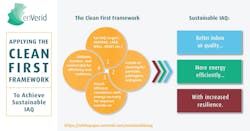Clean First framework describes 4-step process to sustainable IAQ
enVerid Systems, a provider of sustainable indoor air quality (IAQ) technology, has now published a system-level framework for enabling low-energy, high IAQ, climate-resilient buildings.
The Clean First approach is name of the framework, as detailed in a new white paper entitled, "How to Achieve Sustainable Indoor Air Quality: A Roadmap to Simultaneously Improving Indoor Air Quality & Meeting Building Decarbonization and Climate Resiliency Goals."
The white paper was developed in collaboration with leading IAQ and energy efficiency companies 75F, Awair, GIGA, Oxygen8, Planled and SafeTraces, and includes input from more than a dozen built-environment experts.
Per enVerid Systems:
The Clean First framework is based on a four-step process that building owners and operators, architects, energy efficiency consultants, and mechanical engineers and contractors can follow to achieve sustainable IAQ: better indoor air quality more energy efficiently with improved resilience to outside air pollutants, including wildfire smoke and ozone.
The framework draws on lessons learned from the pandemic and recent updates to building standards to address the growing need to decarbonize both new and existing commercial buildings while simultaneously improving IAQ.
The core thesis of the new white paper is that improving IAQ with optimized ventilation and air cleaning need not conflict with building decarbonization and climate resilience goals and, in many cases, can reduce a building's carbon footprint.
"To create high-IAQ, low-energy, climate resilient buildings for the future, we need to embrace alternatives to outside air ventilation to maintain healthy indoor environments," said William Bahnfleth, Ph.D., P.E., Fellow/Presidential Member ASHRAE, The Pennsylvania State University, who added, "Building on key lessons from the COVID-19 pandemic about layered air cleaning strategies, the Clean First framework presented in this paper lays out a well-constructed, system-level approach to achieve Sustainable IAQ. I encourage designers and engineers to read the paper and consider incorporating its recommendations into future projects."
As described in the white paper, the Clean First framework is based on the concept that air cleaning, filtration, and ventilation can be deployed flexibly and interchangeably to efficiently and cost effectively achieve IAQ targets for particles, pathogens, and gaseous contaminants.
A key aspect of the framework is validating IAQ performance through testing and continuous monitoring and using smart building controls to dynamically adjust air cleaning and ventilation for IAQ, efficiency, occupant comfort, and climate resiliency. This system-level approach is summarized in 12 key recommendations associated with the four steps of the framework.
"It is time to embrace a Clean First approach to designing and operating buildings to deliver healthy indoor air quality while conserving energy and reducing carbon emissions," said Christian Weeks, CEO of enVerid Systems. "For too long we have been constrained by a false choice of better IAQ or increased energy efficiency from reducing ventilation rates. The Clean First framework shows how combining field validated air cleaning, filtration, and ventilation strategies using existing building standards with continuous IAQ monitoring and dynamic building controls can deliver good IAQ and improve ventilation efficiency at the same time."
"In developing this white paper, enVerid and its collaborators did several valuable things," concluded Jay Stein, Senior Fellow Emeritus, E Source. "They integrated the contributions of an impressive list of organizations, individuals, and sources. Additionally, they take a wide variety of technologies and techniques, and incorporate them into a framework that will enable many building operators and designers to energy-efficiently protect building occupants' health."
